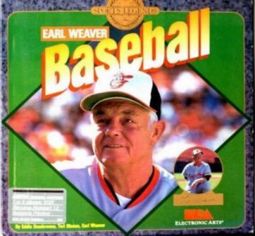Earl Weaver Baseball
| Earl Weaver Baseball | |
|---|---|
 |
|
| Developer(s) | Don Daglow, Eddie Dombrower |
| Publisher(s) | Electronic Arts |
| Platform(s) | Amiga, DOS, Apple II |
| Release date(s) | 1987 |
| Genre(s) | Sports game |
| Mode(s) | Single player, Two Player, Computer vs. Computer |
Earl Weaver Baseball is a baseball computer game (1987), designed by Don Daglow and Eddie Dombrower and published by Electronic Arts. The artificial intelligence for the computer manager was provided by Baseball Hall of Fame member Earl Weaver, then manager of the Baltimore Orioles. EWB was a major hit, and along with John Madden Football helped pave the way for the EA Sports brand, which launched in 1992.
Daglow and Dombrower had previously teamed together to create Intellivision World Series Baseball at Mattel in 1983, the first video game to use multiple camera angles and the first console sports sim.
Daglow and Dombrower interviewed Weaver in his hotel room in a series of meetings over a period of months during the 1985 season for managerial AI. Dombrower actually apologized to Weaver at one point for taking up so much of his free time, but Weaver told him that he never had anything to do during road trips and never left his hotel room, anyway. In addition, he loved talking baseball strategy, and he was having a great time.
EWB included many features that subsequently became part of most or all computer baseball sims through the present day:
The gameplay was unusual in certain respects. The gamer had no control over the fielders, except where to throw the ball. The pitcher/batter interface was top-down in the Amiga version, and foreshortened in the DOS version.
Players were rated from 1 to 10, but the editor allowed players to effectively go up to 15 (after which it reset.) Players with 15 pitching speed, for example, could reach 100+ mph on their fastballs. Players with 15 running speed were already on second on a stolen base when the catcher's throw was 2/3 of the way to second. Also, any player with a runner rating higher than 10 could never be thrown nor tagged out. This meant that every such player would automatically get an inside-the-park home run on any ground bunted ball.
...
Wikipedia
